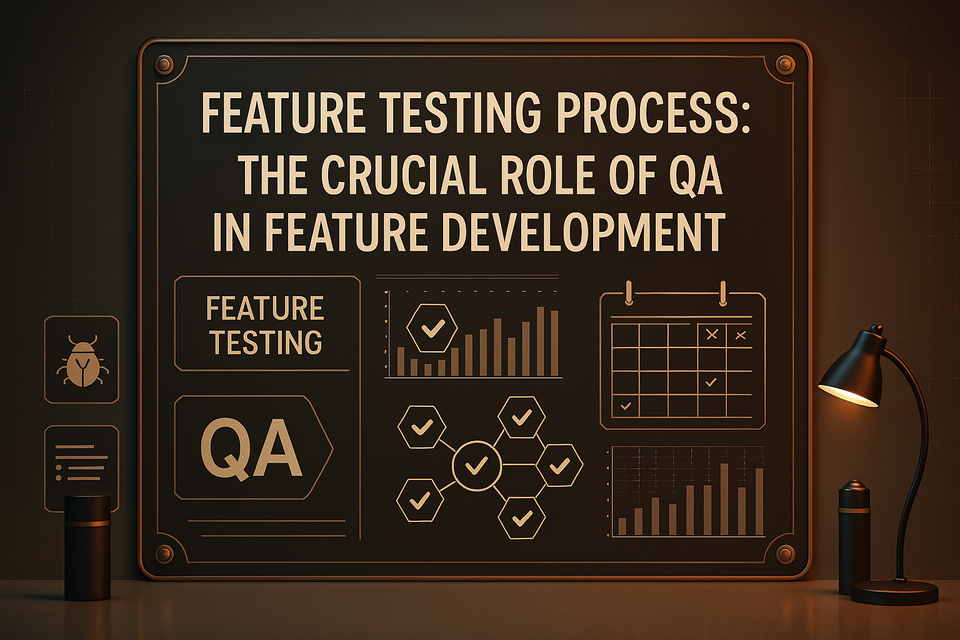Feature Testing Process: The Crucial Role of QA in Feature Development

Feature testing isn’t something that just happens at the tail end of development. In reality, QA needs to start from day one. It’s not just about executing test cases or finding bugs — it’s about being part of the conversation from the very beginning.
When a new feature is introduced, it’s easy to think that QA’s role starts when the code is handed over for testing. But the truth is, the most important QA activities begin long before that.
When the feature idea first arises, be it from a product request, a customer need, or a business goal, QA should be there. From the outset, QA’s role is to ask the right questions:
• What exactly are we trying to solve here?
• Are there any assumptions we need to challenge?
• How could this new feature impact existing workflows?
The early involvement ensures that QA can help define the feature, uncover any potential gaps in understanding, and set the right expectations for what needs to be built.
Feature planning: where QA lays the groundwork
The planning phase sets the tone for the rest of the lifecycle — and it’s where QA has a uniquely valuable role to play.
This is when QA begins shaping the testability of the feature. During refinement or grooming sessions, QA asks:
• Is this feature testable as it’s currently described?
• Do we have enough information to validate the acceptance criteria?
• Are there edge cases or conditions that haven’t been considered yet?
• Is this introducing new risks to high-traffic areas of the product?
These questions aren’t just for curiosity — they form the basis for effective test planning. At this stage, QA begins to form a mental model of the feature, capturing what needs to be tested, how the different scenarios might unfold, and where things might break.
It’s also the point where QA clarifies ambiguities — ensuring a shared understanding across product, design, and engineering. Any misalignment caught here is a bug avoided later.
With this input, QA can already begin outlining test strategies, drafting early test cases, and preparing targeted discussion points for the design phase. Planning is not a passive phase for QA — it’s a high-leverage opportunity to influence both quality and velocity.
The design phase: More than just a visual review
Once the feature moves into design, QA continues the momentum. It’s not just about checking if the feature looks good. It’s about making sure the feature works within the broader system. QA looks for user experience inconsistencies, accessibility issues, and potential usability problems that others might overlook.
Design reviews are crucial, and QA’s involvement here means:
• Evaluating the impact of this design on the user’s journey.
• Ensuring that there’s a consistent experience across the application.
• Identifying any new user behaviors that might create complexity or confusion.
Because QA already engaged in the planning phase, they’re not starting from zero. They arrive at the design review with context, questions, and potential risks already in mind — which means better feedback and stronger alignment across the team.
During development: QA is not waiting on the sidelines
As development progresses, QA should be actively involved — not just waiting for the feature to be done. This is the phase where QA prepares test plans, drafts test cases, and anticipates challenges that might arise during testing.
QA should be integrated into the team’s workflow, not just checking in at the end of the sprint. Regular collaboration during this phase is key. Whether it’s attending standups, reviewing pull requests, or discussing potential risks, QA must be an active participant, helping to ensure that quality is built from the ground up.
Test execution: The first real check
Once the feature is built and deployed to a test environment, it’s time for QA to execute the tests. But it’s not just about ticking boxes on a list. It’s about exploring the feature, going beyond the happy path, and validating how it behaves under real-world conditions.
QA’s role here is to ensure that:
• The feature works as intended.
• It doesn’t break other parts of the system.
• It handles edge cases and error scenarios correctly.
QA needs to ensure full coverage, from expected user interactions to uncommon behaviors that might cause unexpected issues.
Feature Testing and Release Testing Are Not the Same Thing:
Feature testing doesn’t exist in isolation. A feature may work fine on its own, but how does it interact with other components of the system? This is where feature testing diverges from release testing.
While feature testing focuses on the feature in isolation, QA also needs to perform integration and end-to-end testingto ensure that the new feature doesn’t negatively affect other parts of the application.
• Does it impact core flows like login or checkout?
• How does it behave when combined with other new features?
• What happens in edge scenarios where multiple features intersect?
The key difference here is the scale. Release testing ensures that the entire system is functioning together, while feature testing ensures that the individual parts behave as expected in isolation.
QA’s value: Why early involvement matters
When QA is brought in at the end, it’s easy to miss critical context, and bugs become expensive to fix later on. Deadlines slip, and the final product doesn’t meet expectations. However, when QA is involved from the beginning, the benefits are clear:
• Fewer surprises later in the cycle.
• Higher quality features that meet both user and business needs.
• Stronger collaboration between product, design, and development teams.
• Better risk mitigation, catching issues before they snowball.
Involving QA early isn’t just a nice-to-have. It’s a necessity for building high-quality products that function as they should, meeting user needs while remaining scalable and reliable.